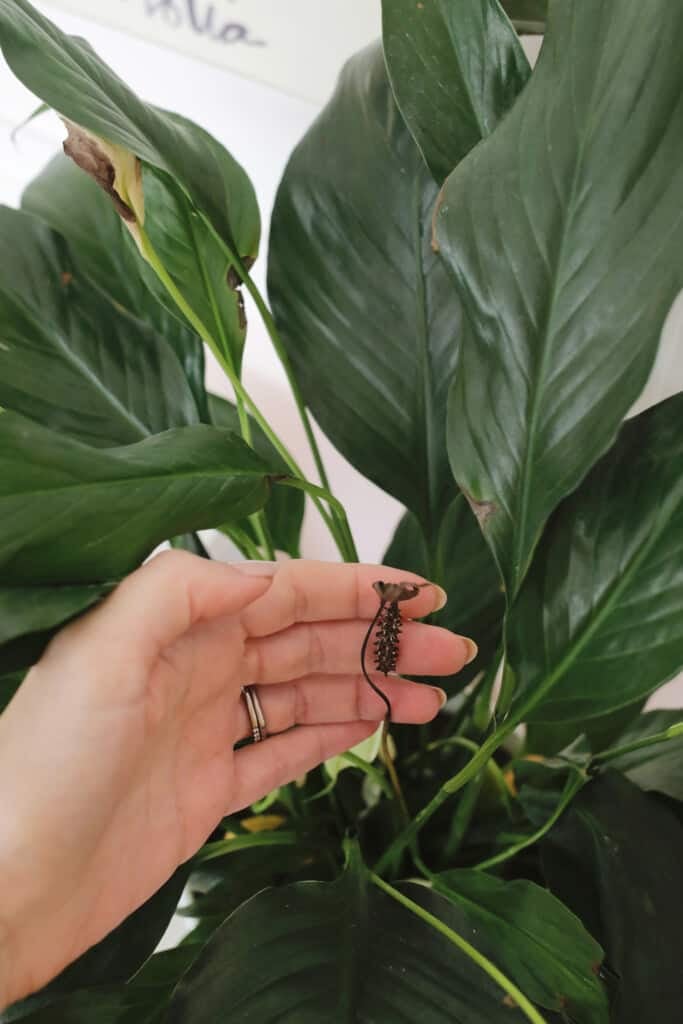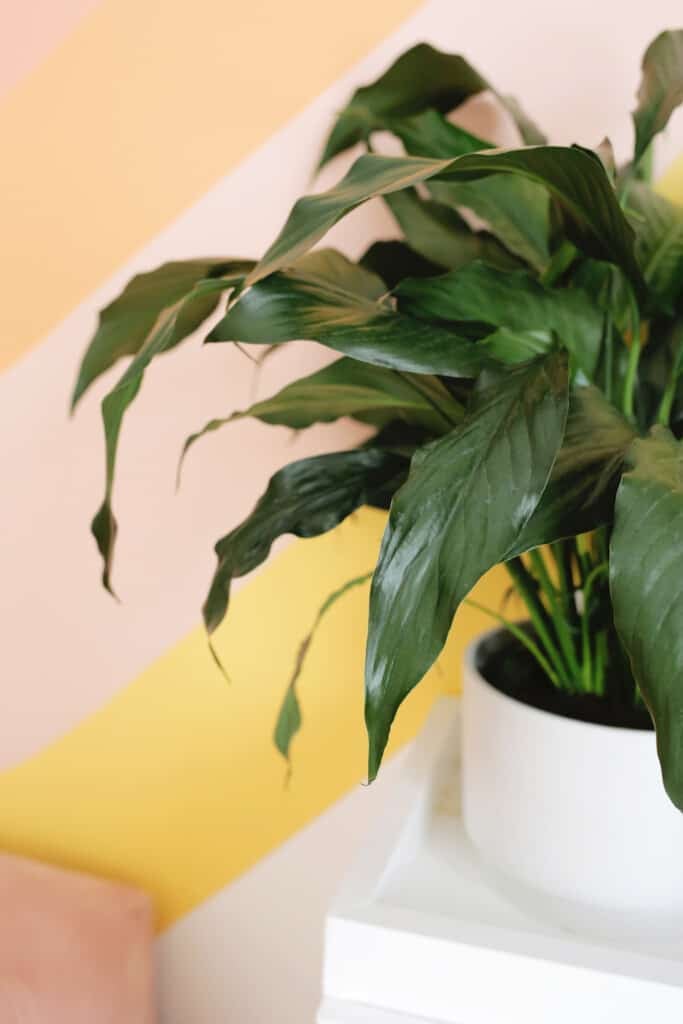Peace lilies are a popular and easy-to-care for houseplant. Known for its glossy green leaves and beautiful white flowers (called spathes) this plant is a symbol of peace and a great addition to any home as they can tolerate low light and even help clean the air!
While they are not true lilies (from the Spathiphyllum species), most peace lilies can grow to be between 1-4′ wide and are tropical plants that come from Central and South America. As long as they get enough light, they will produce lovely white flowers starting in the early summer and may continue to bloom throughout the year.
Peace lilies are not happy in the cold, so they can only be grown outside in warmer more humid climates like in USDA Zones 10 and 11. But we’ll show you how to care for and keep your peace lily happy indoors.
Related: Learn to Care for Pilea Plants, Calathea, Monstera Plants, Spider Plants, Fiddle Leaf Figs, Golden Pothos, Jade Plants, Snake Plants, Rubber Trees, and String of Pearls Plants.

Why are they called Peace Lilies?
Peace lilies get their name from the off white flower that is produced on the plant starting in early summer (it’s actually a white leaf surrounding a cluster of tiny flowers on a stalk). The white flowers are reminiscent of white flags of peace, hence the name!

How often should I water Peace Lilies?
You’ll want to give your peace lily a good full drink when you do water it, but let it dry out in between waterings. You can stick your finger in the soil to check how damp the soil is and wait until it feels mostly dry before watering again. Peace lilies are susceptible to root rot, so make sure the planter you use has drainage holes and don’t let the plant sit in standing water if there’s water in the draining tray.
You can also keep an eye on the leaves as they will start to droop when it needs some water. So if your plant starts drooping about a week after watering, then you’ll start to get an idea of how often to water.
Peace lilies are sensitive to tap water, so if you can’t use distilled, filtered, or rainwater, then let your tap water sit out overnight and that will allow the chlorine to dissipate.
How much sunlight do Peace Lilies need?
While ideally peace lilies enjoy bright indirect sunlight, peace lilies are a good plant to choose if you have a low light area as they also do well in shade to partial shade.
Direct light will dry out a peace lily and cause scorching on the leaves. The more bright light a peace lily gets, the more frequently it will flower, so put it in a brighter spot if you want to get the best blooms.
Should I fertilize?
Peace lilies don’t need much fertilizer, but you can use a 20-20-20 fertilizer mixed at one quarter strength to fertilize through the growing season (spring and summer) every other month.
Repotting Peace Lilies
Peace lilies don’t mind being a little pot-bound, but if you see roots starting to grow up through the surface or out the bottom drainage holes, it’s time to move it to a bigger pot. Loosen the roots gently with your hands to break them up a bit and that will encourage the roots to spread out.
Choose a pot that is only about 2″ bigger than the current size as too big a pot will hold too much moisture for the plant and promote root rot. While it’s best to re-pot during the growing months of the year (spring and summer), repotting can be done at any time of the year and you’ll want a good soil that combines drainage and moisture retention.
Temperature and humidity for Peace Lilies
Ideal indoor temperatures for peace lilies are between 65°F and 75°F and you’ll want to keep them away from drafty doors or windows. If you keep a potted plant outside, make sure to bring it in once temperatures dip into the 50°s.
Being a tropical plant, peace lilies enjoy humidity, so giving them light mistings with a spray bottle will help them feel more at home. You can also place them on top of gravel on a tray and then pour some water into the gravel, which will create humidity around the plant as it evaporates. Just make sure the water level is below the gravel so the plant is not sitting directly in water.


Pruning Peace Lilies
Once a stalk has flowered, that stalk won’t produce any more blooms, so you can cut the stalk off at the bottom with clean scissors or shears (make sure to disinfect your snippers with isopropyl alcohol between cuts so you don’t spread disease).
Yellowed or shriveled leaves can also be cut off at the base to clean up the appearance of the plant.
Propagating Peace Lilies
You can divide peace lilies into several plants by removing it from its pot and gently trying to separate the crowns of the plant. You can also use a sharp knife to cut the roots if they won’t separate easily and then simply replant the pieces in their own container with a good soil that combines drainage and moisture retention.
Can Peace Lilies grow in water?
Peace lilies can be grown in water rather than a traditional soil container. You can grow them in water by:
- Taking it out of its pot and rinsing the soil off the roots with lukewarm water (cut off any roots with signs of root rot).
- Position the plant in a clean glass vase so its roots are touching the bottom.
- Add distilled, filtered, or rainwater to the vase to cover the roots. Make sure it doesn’t go all the way up to the leaves or stems as the water will cause them to rot.
- You can add a few drops of liquid fertilizer and place it in indirect sunlight to help it grow.
To minimize transplant shock, you can also add some soil that the plant was in to the water and then change the water weekly to have less and less soil until it’s all water. This will acclimate it more slowly to the water for a better chance of success.

Diagnosing common problems
- Brown leaf tips: Could be from using tap water. Try trimming the brown parts off the leaves if you like (although leaving them doesn’t hurt the plant) and using filtered, distilled, or rainwater instead. Or you can leave out your tap water overnight in your watering can before watering and that will help dissipate the chlorine.
- Pests: Small pests like spider mites and aphids can bother peace lilies, but you can wipe off the leaves and then spray with an insecticidal soap to keep bugs away.
- Plant not flowering: Peace lilies need a certain amount of light to flower, so you may need to move them to a sunnier spot to encourage flower growth.
- Green or weak flowers: Green flowers can be a sign of over-fertilizing, while weak flowers can mean your plant could use a dose of fertilizer to strengthen the plant a bit (try one that is made for flowering plants).
Frequently Asked Questions
Are peace lilies toxic to pets or kids?
Yes, peace lilies are mildly toxic and can cause stomach and respiratory irritation due to the calcium oxalate in all parts of the plant. Keep out of reach of pets and small children.
Do peace lilies clean the air?
Yes, they are on on NASA’s list of top 10 air-cleaning plants as peace lilies add oxygen to the air and remove toxins like benzene, formaldehyde, and carbon monoxide.
